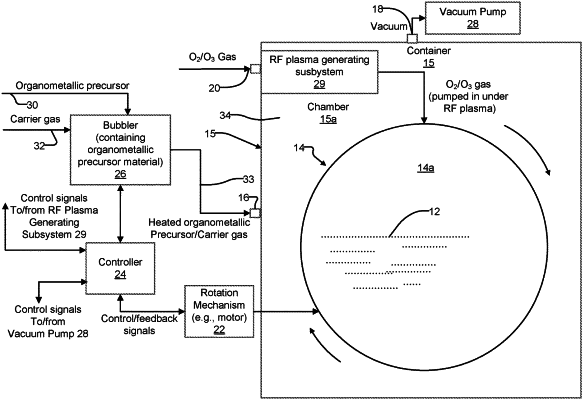| CPC C23C 16/45555 (2013.01) [C23C 16/403 (2013.01); C23C 16/45536 (2013.01); C23C 16/45544 (2013.01); C23C 16/45553 (2013.01)] | 16 Claims |

|
1. A method for applying a doping material on a quantity of powder particles, comprising:
providing a controller;
providing a stationary container having:
an RF plasma generating subsystem disposed within the container and in communication with the controller;
a central chamber having a first port for receiving a heated, precursor/carrier gas, a second port forming a vacuum port for enabling the container to be placed in a vacuum condition, and a third port for receiving an O2/O3 gas);
locating a rotatable metal cylinder within the central chamber of the container, the rotatable cylinder being rotatable independently of the container;
operatively coupling a rotation mechanism to the rotatable cylinder, the rotation mechanism being controlled via first control signals supplied from the controller;
charging the rotatable cylinder with a quantity of powder particles;
heating a quantity of precursor contained within a bubbler, the bubbler being independent of the container, to sublime the precursor;
controlling a temperature of the bubbler, and rotation of the rotatable cylinder, using the controller;
feeding a quantity of carrier gas into the bubbler and mixing the quantity of carrier gas with the heated precursor within the bubbler to form a mixture of heated precursor/carrier gas;
charging the central chamber with the heated precursor/carrier gas through the first port in the container;
using the rotation mechanism to cause rotational movement of the rotatable cylinder within the container while the container is held stationary to cause tumbling of the powder particles, to produce an interaction of the powder particles with the heated precursor/carrier gas within the rotatable cylinder to form a first monolayer coating on each of the powder particles;
removing the heated precursor/carrier gas from the central chamber by using second control signals supplied from the controller to control a vacuum pump, the vacuum pump being in communication with the stationary container and activated by the controller upon the expiration of a predetermined time period, the predetermined time period being indicative that the first monolayer coating on each of the powder particles has been fully formed;
charging the central chamber through the third port with a O2/O3 gas), and into a plasma generating subsystem;
using the plasma generating subsystem to direct the O2/O3 gas) under a plasma into the rotatable cylinder, the plasma generating subsystem further being controlled by the controller; and
causing further rotational movement of the rotatable cylinder while maintaining the container stationary, to cause further tumbling of the powder particles contained within the rotatable cylinder, to produce interaction of the O2/O3 gas) with the first monolayer coating on each said powder particle to modify the first monolayer coating to create a different, single monolayer coating forming an oxide coating on each of the powder particles, wherein the different, single monolayer coating forms a dopant for the powder particles.
|